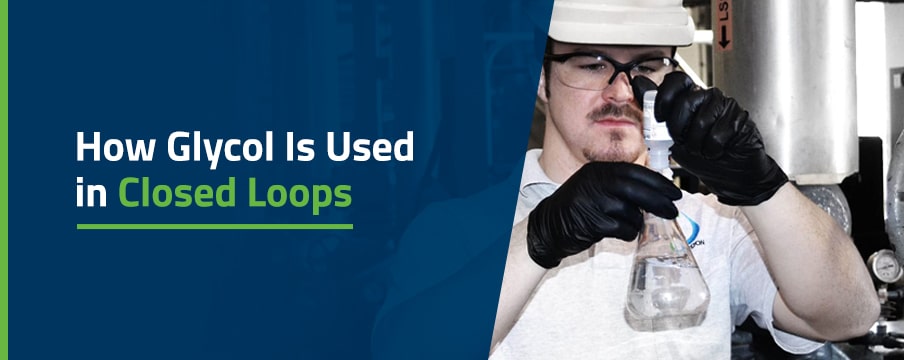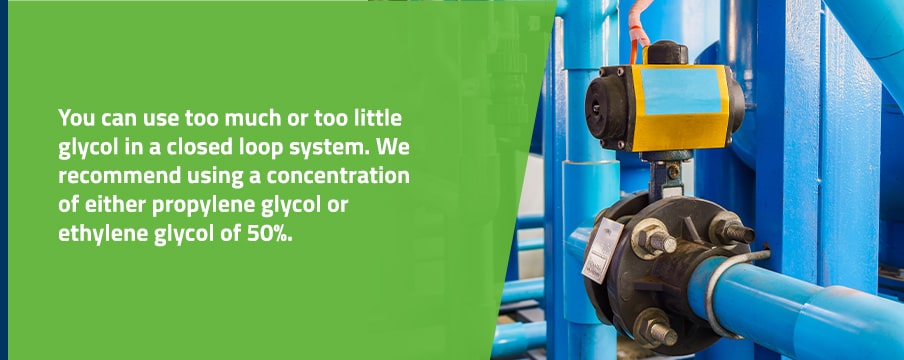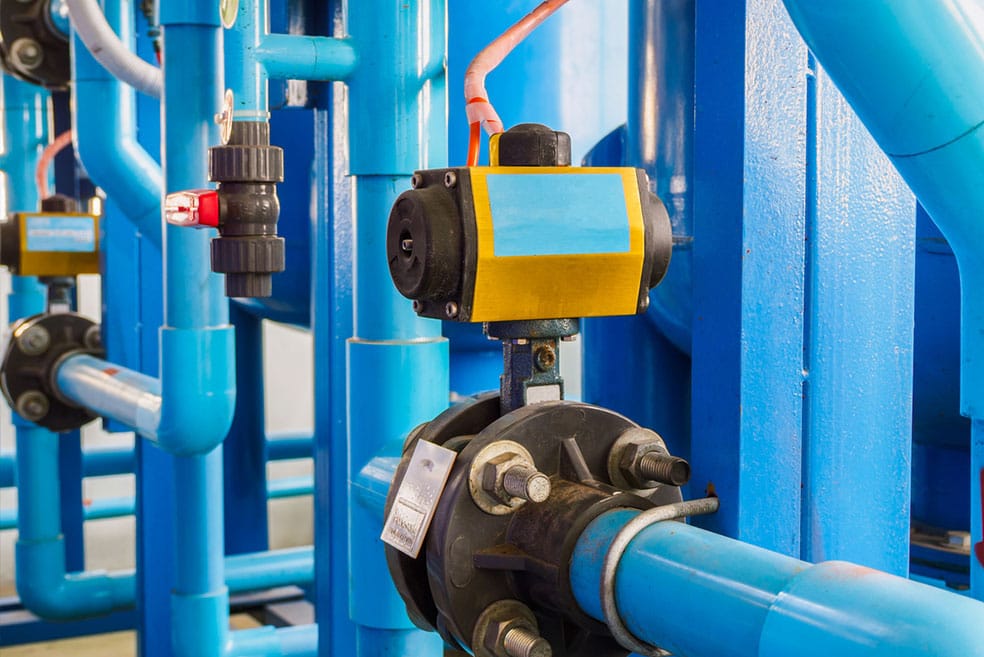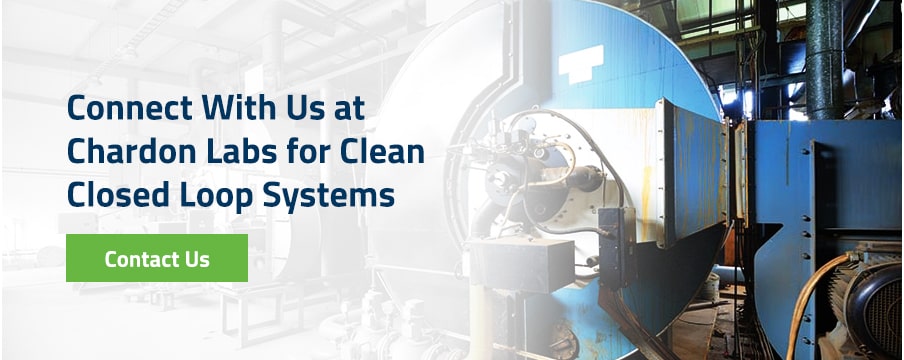
Table of Contents
- How Glycol Provides Freeze Protection
- Other Chemicals in Closed Loop Systems
- Potential Problems in a Closed Loop System
- How to Test for Glycol
- How Often to Replace Glycol in a Closed Loop System
- Types of Glycol Used for Closed Loop Systems
- The Difference Between Ethylene Glycol and Propylene Glycol
- Contact Us
Glycol is a chemical used in closed loop systems to protect the fluid from freezing. It is only one of the chemical treatments applied to the fluid in these systems to prevent problems and extend the efficiency of the system’s cooling ability. Recognizing the importance of glycol and other chemical treatments in these systems starts with understanding how they work.
How Glycol Provides Freeze Protection for Closed Loop Systems
For closed loop systems to function properly, the water inside must continuously flow, regardless of external conditions. Areas of the loop exposed to subfreezing temperatures need to incorporate freeze protection to the water by adding glycol. Glycol’s interaction with water reduces the freezing point of the liquid inside the system, so it requires much colder temperatures before the liquid freezes.
How Glycol Alone Prevents Freezing in a Closed Loop System
In a closed loop system, the water could freeze if exposed to temperatures below 32 degrees Fahrenheit. By adding ethylene glycol to the water to create a 60% solution, the freezing point plummets to minus 60 degrees Fahrenheit.
Glycol has a freezing point of minus 39 degrees Fahrenheit. When mixed with water, the properties of the two combine to create a lower freezing point than either could have individually. This interaction also helps to provide burst protection and freeze protection for the closed loop system.
Freeze Protection Versus Burst Protection
Freezing water expands, causing pipes in a closed system to burst. Adding glycol to the water helps prevent both freezing and bursting, depending on the type of glycol used and its concentration.
Freeze protection prevents the water from freezing, allowing it to continue to flow. However, burst protection preserves the pipes from breaking if the liquid inside does freeze.
As temperatures drop around a closed-loop system with a glycol solution in it, the water will freeze and separate or precipitate out of the mixture. The frozen water makes the glycol solution slushy. If the slush does not last long and has a low viscosity, most systems will stand up well.
While water expands when frozen, glycol reduces in volume. When the temperature drops low enough for glycol to freeze, it will contract, lowering the total solution volume in the pipes and preventing breaks.
In short, freeze protection uses glycol to prevent freezing of the solution, while burst protection’s glycol solution protects the pipes from bursting in the rare instance of a freeze.
Related Case Study
Other Chemicals in Closed Loop Systems
Closed loop systems need other additives and treatments to prevent corrosion inside the system. Effective treatments include products to remove oxygen from the system’s water to slow the rate of corrosion. Other chemicals control the pH of the water to within a precise noncorrosive range. Lastly, protective chemicals that coat the inner surfaces prevent damage from corrosive products. Some examples of closed loop chemicals that we use include:
- Charlumina: Chilled systems that have aluminum components may use this azole- and sulfite-based corrosion inhibitor.
- CTA-800: This product prevents foaming inside closed loop systems.
- SN-7: SN-7 scavenges oxygen and creates a protective inner layer on brass, copper and similar alloys in chilled systems.
- SN-10: Hot loop systems that need a protective layer inside the metal surfaces and to have oxygen drawn out may use SN-10.
- SN-88: Similar to the operation of other SN inhibitors, SN-88 works best in systems with low-conductivity.
When taking measures to prevent corrosion in a closed loop system, though, simply adding chemicals to a system with chemical buildup or existing corrosion will not suffice. The first step for any treatment of a closed loop system, whether by adding glycol for freeze prevention or incorporating corrosion protection, should be cleaning and flushing the system. The chemicals that protect the interior from corrosion will only work when applied to clean surfaces.
Glycol does not provide corrosion protection alone. For systems that contain galvanized steel or aluminum, glycol solutions can cause localized corrosion. Specialty Dow inhibited glycol solutions already contain corrosion inhibitors and don’t need additional products. However, green-colored glycol products may benefit from adding SN solutions to prevent corrosion.
Potential Problems in a Closed Loop System
Automatically adding fresh water to a closed loop system presents potential problems for systems that use glycol. By not regulating the amount of water added, the glycol solution could dilute too much to provide adequate freeze or burst protection. To mitigate the problem of creating unknown concentrations of glycol, either use a glycol feed system or a water meter.
Another issue with glycol closed loop systems is the volume required for the glycol. The expansion tanks should have a 4% higher volume when used with a system that contains glycol compared to one that does not use this chemical.
Lastly, make sure to use quality water without minerals when diluting glycol for a closed system. Municipal water supplies frequently contain minerals and added chemicals that could interact with the chemical inhibitors used in the glycol solution, preventing it from protecting the interior of the system.

How to Test for Glycol to Ensure Adequate Freeze Protection
You can use too much or too little glycol in a closed loop system. We recommend using a concentration of either propylene glycol or ethylene glycol of 50%. This amount ensures freeze protection down to minus 25 degrees Fahrenheit. Using too much glycol reduces the amount of heat the system can hold, thereby decreasing efficiency and increasing energy costs as the closed loop system struggles to properly cool or heat.
To determine the percentage of glycol in your closed loop system, test the water with a refractometer. This device will give the temperature at which the solution will freeze. This information will help you to determine the percentage of glycol by using a conversion table.
How Often Do I Need to Replace Glycol in a Closed Loop System?
The time between replacing the glycol in a closed loop system relies on several variables. For instance, heated systems that frequently exceed 250 degrees Fahrenheit may experience a more regular breakdown of the glycol, requiring more frequent changes. The same increase in replacement frequency happens in systems that have contamination. For uncontaminated systems that are truly closed loop in design and do not require makeup water, the glycol will last for years.
The best way to determine when to replace glycol comes from regularly testing the pH, ammonia, copper and iron levels in the liquid. As glycol breaks down, it turns into glycolic acid, lowering pH and potentially leaching metals or ammonia into the solution.
Types of Glycol Used for Closed Loop Systems
Common types of glycol used in closed loop systems include propylene glycol and ethylene glycol. These chemicals also have variations in them based on the presence of inhibitors or other additives. At Chardon Labs, we commonly use the following:
- Dowtherm SR-1: Fluorescent pink ethylene glycol
- Dowtherm 4000: Fluorescent orange ethylene glycol
- DowFrost: White propylene glycol
- DowFrost HD: Bright yellow, low-toxicity propylene glycol for food applications
While automotive antifreeze, which is bright green, technically contains glycol, do not use it in a closed loop system. This product contains silicates, which can negatively impact heat transfer. Additionally, the coloring makes most water chemistry tests impossible to interpret. Avoid this type of product in closed loop systems. Only use ethylene or propylene glycol.
Differences Between Ethylene Glycol and Propylene Glycol
Ethylene glycol is most commonly used for closed loop system freeze protection due to its extremely low freezing point and ability to contract when it freezes. However, for any systems that process food or have potable water contact with the glycol, ethylene glycol will not suffice due to its toxicity.
Propylene glycol has a more environmentally friendly profile. It also is less toxic and acceptable in some forms for food preparation or manufacturing areas. However, propylene glycol has a higher freezing point than ethylene glycol. It also breaks down faster and does not provide burst protection.
Read More About Glycol in Closed Loops
Click here for the part 2 article on glycol in closed loop systems.
Connect With Us at Chardon Labs for Clean Closed Loop Systems
Don’t just buy chemicals. Purchase clean systems from Chardon Labs. Our technically proficient teams, trustworthy work and cost-effective solutions provide facilities with closed loop cooling systems the means of getting and staying clean and operating efficiently. For more information about how we go beyond selling chemicals to providing ways of keeping systems clean, contact us at Chardon Labs.

Matt Welsh
Matt Welsh is the Vice President and Water Consultant at Chardon Labs. He helps consult a wide range of customers utilizing various methods of water treatment, from chemical to chemical-free approaches, large and small applications, and across a wide range of geographical influences. With 20 years of water treatment experience, including a wide range of troubleshooting and service in potable water and non-potable HVAC and industrial applications, he is an expert in water treatment chemistry for cooling towers, boilers, and closed-loop systems.


